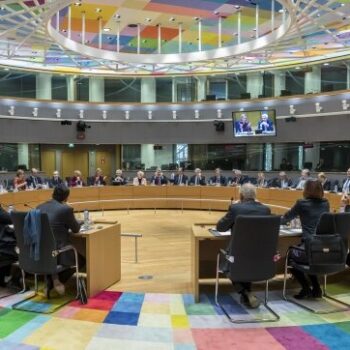A verbal fog of war has now enveloped the Copenhagen negotiations. This is inevitable. As well as the normal noise of negotiation there is now a fury of manoeuvring to manage expectations. Spin machines are working overtime to ensure that those seeking to evade the obligations of a strong and effective treaty are concealed by a protective smokescreen of ambiguous words.
Penetrating this fog is difficult. It requires a reliable linguistic radar to pick out the truth from the false echoes of ambiguity. Considerable caution is needed to avoid falling into the dangerous quagmires of marginal detail. Above all it is important to remember where you came from and where you are trying to get to.
The tortuous progression from the Earth Summit in 1992 via the Kyoto Protocol in 1997 to the Bali Roadmap in 2007 constructed today’s global regime for tackling climate change. This regime is based on a political bargain. At its heart is the agreement by the industrialised nations to reduce their carbon emissions first and to help the developing countries financially both to adapt to a changing climate and to reduce their carbon emissions.
More successful
In return, the developing countries undertook to take actions that would lower their emissions below where they otherwise might have been. This asymmetric bargain reflected the recognition by the industrialised nations that they were responsible for most of the cumulative carbon burden in the atmosphere. It is embodied in the key principle of ‘common but differentiated responsibilities’.
This regime, cumbersome though it is, has been more successful than its critics recognise. Carbon emissions in many industrialised nations are below where they were in 1990 and considerably below where they might otherwise have been. Money has flowed, albeit too little and too slowly, to the developing countries. There has been a massive increase in our knowledge of the causes and consequences of climate change. The issue has moved from the political margins to become one of the top three issues on the global agenda.
Driven, as was always intended, by the successive reports of the Intergovernmental Panel on Climate Change (IPCC), governments everywhere are now much more aware of the systemic risk posed by a changing climate. Institutional capacity has been strengthened: more ambitious national policies adopted.
In ratifying the United Nations Framework Convention on Climate Change (UNFCCC) all nations, including the United States, undertook an obligation to work to avoid ‘dangerous’ change to the climate. However, the Convention did not specify how much climate change would be dangerous.
In 2007, the IPCC’s fourth report warned that greenhouse gases were causing more and faster change than had been previously thought. There is now clear advice from climate scientists that governments should aim to keep the eventual rise in global temperature below 2 degrees. In July this year, the leaders of those countries responsible for most of the world’s current emissions, including the US, China and India, formally accepted this advice.
Thus we now have a clear destination for the climate regime to be agreed in Copenhagen. In effect, 2 degrees has been established as the threshold of dangerous climate change. If Copenhagen sets the world on course to stay below this level it will have succeeded. If not, it will have failed.
If we could lift the thickening fog of war the key elements of a successful agreement would be clear to everyone. To have a reasonable chance of staying within the 2 degrees limit the concentration of greenhouse gases in the atmosphere needs to be kept below 450 parts per million CO2-equivalent. To get there, global carbon emissions must peak by 2020 and be reduced by at least 50% from 1990 levels by 2050.
Politically Binding
The EU and the US have already set this as the long run goal of their climate policy. But because the build up of carbon in the atmosphere is cumulative, you cannot leave getting there to the last minute. This means setting mid-term targets.
These mid-term targets for the industrialised nations are the key to the whole Copenhagen agreement. To put the world onto the right path to stay below 2 degrees, the industrialised nations must agree to a binding commitment to reduce their emissions 25-40% below 1990 levels by 2020.
The developing countries would not yet need to make binding commitments to reduce their emissions below current levels. But they would have to make binding commitments to programmes of action to reduce their emissions below where they might otherwise have been. In the jargon of the negotiations these actions would have to be ‘measurable, reportable and verifiable.’
In return for these commitments the industrialised nations would provide finance to the tune of about $100 billion annually by 2020. This finance would be available in part to support the action programmes to reduce emissions and in part to pay for adaptation in climate vulnerable countries. Some 30% of these capital flows would be from public sources but the majority would be in the form of private capital flows – largely financed by the purchase of carbon off-sets needed to meet the industrialised nations’ emissions reduction commitments.
This is the essential heart of the deal to be done at Copenhagen. If this deal, or something close to it, cannot be struck then the whole global climate regime is in doubt. There are, of course, many other issues and a lot more details any one of which could block agreement. But the closer we are to getting the core deal the less likely this is.
The reason the verbal fog of war is thickening so rapidly stems from a growing lack of confidence that this deal can be struck in December. This has led to the proposal to settle for a political declaration in Copenhagen which might or might not lead to a ratifiable treaty.
It has stimulated the Danish Prime Minster to talk beguilingly of a ‘politically binding’ agreement for ‘immediate implementation’. This is simply hand waving. All anyone can do immediately is what they have already committed themselves to do. In which case, what is being negotiated? The term ‘politically binding’ has no meaning at all in diplomacy. It is simply a promise by a politician worth as much as any other such promise.
The intent of such slippery use of language is to manage the headlines not to change the outcome. There will be a lot more of it as we get closer to Copenhagen without resolving the real problems with getting a legally binding treaty in December. The central problem boils down to finding a way for the United States to re-enter the global regime without wrecking it in the process.
Neither the rest of the industrialised world, nor the developing world, is willing to make further emissions reductions commitments until they know what the US will put on the table. Since these commitments are what drive the whole regime, there is an understandable unwillingness to agree all the other issues until they are known.
It is the fading prospect of the passage of US domestic legislation to underpin US reduction commitments before December which has undermined confidence that a treaty can be agreed in Copenhagen. In effect, no US commitments, no deal. The world, and the US negotiators, are sensibly wary of repeating the Kyoto experience where the US signed up to international obligations it later had to repudiate in the face of Congressional opposition.
In itself, this is not an insurmountable problem. The US is serious in its desire to rejoin the global climate regime. The rest of the world is equally anxious that it should do so. There is a well established device in international negotiations of ‘stopping the clock’ to avoid an otherwise available agreement being lost by running out of time.
If the US cannot pass its legislation by June 2010, it is very unlikely to be able to pass it in 2010, if at all. This defines for how long the clock must be stopped. Anything longer and we will be on the road to never-never land. In formal terms, that means that the negotiations in December would be adjourned not concluded.
This is the key point. It is one thing to agree to play extra time, quite another to ask for a replay. To accept a political declaration in Copenhagen that does not contain an unambiguous commitment to agreeing a ratifiable treaty by a specific date before June 2010 would be to give up establishing a climate regime with any prospect of staying below 2 degrees. It would be asking for a replay that might never happen.
If a political declaration is all that can be agreed in December it must be a postponement, not a cancellation. If it is to be a postponement that does not morph insidiously into a cancellation it must agree to a specific date by which a ratifiable treaty will be finalised. If you cannot find that date, it is not there. If it is not there, you have more fog, not a deal that will avoid dangerous climate change.
*This briefing is published with the permission of ENDS magazine. It will appear in a forthcoming special supplement on climate change to be published towards the end of November 2009.


